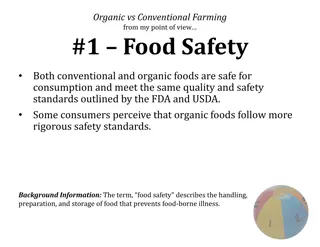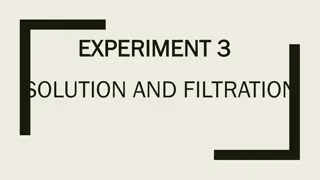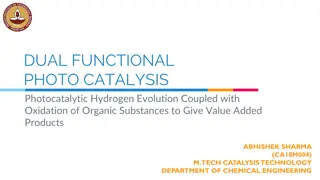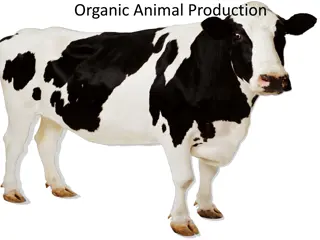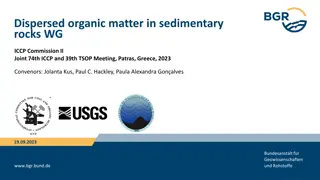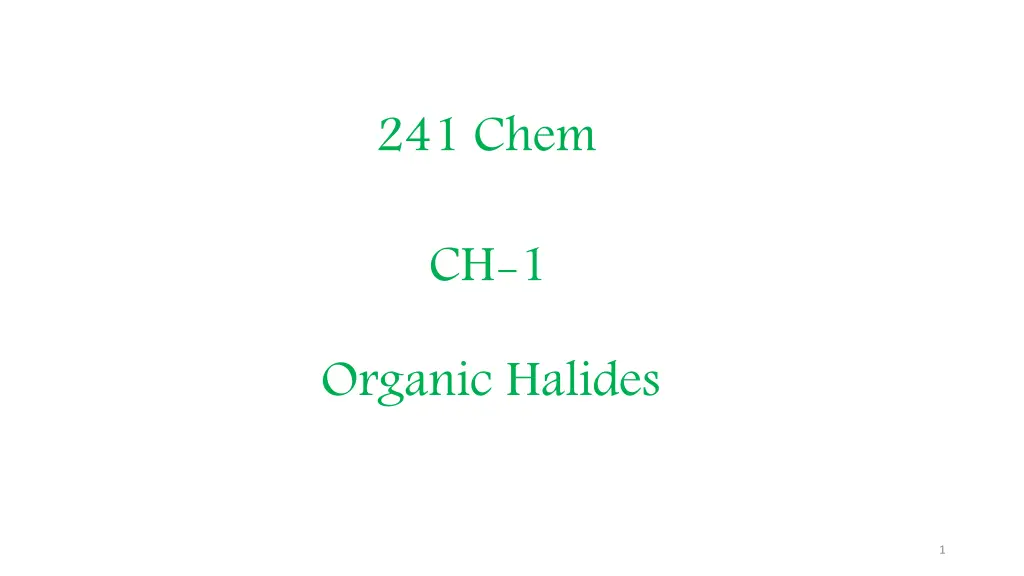
Understanding Organic Halides and Their Classification
Explore the world of organic halides with a focus on their structure, nomenclature, preparation methods, and uses. Learn about alkyl, vinylic, aryl, allylic, and benzylic halides, along with their distinct characteristics and applications in chemistry.
Uploaded on | 0 Views
Download Presentation

Please find below an Image/Link to download the presentation.
The content on the website is provided AS IS for your information and personal use only. It may not be sold, licensed, or shared on other websites without obtaining consent from the author. If you encounter any issues during the download, it is possible that the publisher has removed the file from their server.
You are allowed to download the files provided on this website for personal or commercial use, subject to the condition that they are used lawfully. All files are the property of their respective owners.
The content on the website is provided AS IS for your information and personal use only. It may not be sold, licensed, or shared on other websites without obtaining consent from the author.
E N D
Presentation Transcript
241 Chem CH-1 Organic Halides 1
Learning objectives In this chapter will discusses the following topics and by the end of this chapter the students will: Recognize the structure and classes of alkyl halides. Knowing the common names and understand the IUPAC rules for nomenclature of halo compounds. Understand the physical properties of halo compounds (solubility and boiling points). Knowing the different methods used in preparation of halo compounds. Knowing the reactions of halo compounds; nucleophilic substitution, elimination, reduction reactions of Grignard reagents and know the previously disused methods of reducing alkyl halides. SN1 and SN2 mechanisms E1 and E2 mechanisms 2
Organic Halides and their uses Organic Halides are a large class of natural and synthetic chemicals that contain one or more halogens (fluorine, chlorine, bromine, or iodine) combined with carbon and other elements. Halogen compounds are very important for several reasons: Simple alkyl and aryl halides (especially: Cl & Br) are versatile reagent in syntheses. Halogen can be converted to unsaturated compounds through dehydrogenation (Elimination reactions). Halogen can be replaced by many other functional groups (substitution reactions). Some halogen compounds, especially those that contain two or more halogen atoms per molecule, have practical uses; for example, as solvents, insecticides, cleaning fluidsm and refrigerants, and in polymers such as Teflo. 3
Classification Alkyl Halides 1.Alkyl Halides, R- X :compounds which have a halogen atom bonded to one sp3 hybrid carbon atom. Alkyl halides are also called haloalkanes.( primary (1 ), secondary (2 ) or tertiary (3 )) CH3-CH2-Br Ethyl bromide CH3-Cl Compound (CH3)2-CHF Isopropyl fluoride Common name Methyl Chloride IUPAC name Chloromethane Bromoethane 1 2-Fluoropropane 2 Class 1 C l I Compound B r Common name Methylcyclopentyl chloride Cyclohexyl Iodide Iodocyclohexane 2 t.Butyl bromide 2-Bromo-2-methylpropane 3 IUPAC name 1-Chloro-1-methylcyclopentane 3 Class 4
Classification Alkyl Halides 2. Vinylic Halides, : has a halogen atom bonded to one sp2 hybrid carbon atom. C=C-X B r Cl Common name: Vinyl bromide IUPAC name: Bromoethene 4-Chloro-cyclopentene 3. Aryl Halides, Ar-X : has a halogen atom bonded directly to an aromatic ring. B r C l p-Bromotoluene or 4-Bromotoluene Chlorobenzene 4. Allylic Halides, C=C-C- X : has a halogen atom bonded to one sp3 hybrid carbon atom. C l Common name: Allyl chloride IUPAC name: 3-Chloro-1-propene 5. Benzylic halides, Ar-C-X : has a halogen atom bonded to Carbone one away from aromatic ring. C l Common name: Benzyl Chloride IUPAC name: Chloromethylbenzene 5
Nomenclature OF Alkyl halides IUPAC names derived from the names of parent organic compound (alkane or alkene or alkyne or alcohol or aldehydes and so on) with a prefix indicating halogens and their positions. Common names derived from the corresponding alkyl group followed by the name of halogen atom. I Br CH3Br CH3CH2CH2F 1-Fluoropropane n-Propyl fluoride CH3CHCH2CH3 2-Iodobutane sec-Butyl iodide CH3CHCH3 2-Bromopropane Isopropyl bromide IUPAC name: Commom name: Bromomethane Methyl bromide CH3Cl CCl4 CH2Cl2 (CH3)3C Cl Tetrachloromethane Carbon tetrachloride Trichloromethane Chloroform Dichloromethane Methylene chloride 2-Chloro-2-methylpropane tert-Butyl chloride 6
CH2Cl Cl Cl Chloroethene Vinyl chloride Chloromethylbenzene Benzyl Chloride 3-Chloro-1-propene Allyl chloride IUPAC name: Commom name: Br I Cl H3C 4-Bromocyclohexene 1-Chloro-3-methylcyclopentane Iodocyclohexane Cyclohexyl Iodide Cl Br CH Br Cl 2-Bromo-4-methylpentane 2,5-Dichloro-4-ethylheptane Bromodiphenylmethane Diphenyl methyl bromide 7
Types of Dihalides Geminal dihalide (Latin, geminus, twin ) has the two halogen atoms bonded to the same carbon atom. Vicinal dihalide (Latin, vicinus, neighboring ) has the two halogens bonded to adjacent carbon atoms. 8
Physical Properties Polarity Fluorine, chlorine, and bromine are all more electronegative than carbon ; as a result, C-X bonds with these atoms are polarized with a partial negative charge on halogen and a partial positive charge on carbon. 9
Physical Properties Solubility Alkyl halides have some polar character, but only alkyl fluorides have an atom that can form a hydrogen bond with water. The other alkyl halides are less soluble in water In General, all organic halides are insoluble in water and soluble in common organic solvents. The boiling point The boiling points of alkyl halides increase with increasing molecular weight. CH3CH2CH2Br bp = 71oC CH3CH2CH2F bp = 47oC CH3CH2CH2I bp = 102oC Alkyl halides have higher boiling point than the corresponding alkanes, alkenes, and alkynes because: 1. Polarity 2. Molecular weight CH3CH2Br bp = 38oC CH3CH3 bp = -89oC Branching of the alkane chain lowers the boiling point. CH3CH2CH2CH2Br bp = 101oC (CH3)3C-Br bp = 73oC 10
Preparation Of Organic Halides 1- Direct halogenation of hydrocarbons A) Halogenation of Alkanes: Substitution reaction called Free-Radical Reaction Chlorination Bromination Multiple Halogen Substitution Mechanism: 11
Preparation Of Organic Halides B. Halogenation of alkenes: Electophilic Addition CCl4 Markovnikov s Rule Mechanism: CCl4 12
Preparation Of Organic Halides C. Halogenation of alkynes : Electophilic Addition Markovnikov s Rule propyne 13
Preparation Of Organic Halides D.Halogenation of aromatic ring and alkyl benzene: Electrophilic Aromatic Substitution: Halogenation CH3 CH3 CH2Cl CH3 Cl Cl2, FeCl3 Cl2 + light or heat Cl Radical Substitution Electrophilic Substitution 14
Preparation Of Organic Halides 2-Conversion of alcohols into alkyl halides: Nucleophilic Substitution 1-Pentanol 1-Chloropentane 15
Reactions Of Halocompounds 1. Nucleophilic Substitution Reactions 2. Elimination Reactions 3. Formation of Grignard reagent and its reactions 4. Reduction of alkyl halides 16
Reactions Of Organic Halides 1- Nucleophilic Substitution Reactions (SN1 and SN2 ) SN2 : Bimolecular Nucleophilic Substitution SN1 : Unimolecular Nucleophilic Substitution Hint: Rearrangement 17
Factors Favoring SN1 versus SN2 Reaction: Reactions of Common Nucleophiles with Alkyl Halides: 18
Reactions Of Organic Halides 2- Elimination Reactions (E1 and E2 ) E2 : Bimolecular Elimination E1 : Unimolecular Elimination Hint: Rearrangement 20
Substitution and Elimination in Competition: Zaitsev s Rule Hint: 21
Reactions Of Organic Halides 3- Formation of Grignard reagent and its reactions: Reactions of Grignard reagent: Propane 2-Bromopropane 22
Reactions Of Organic Halides 4- Reduction of alkyl halides: Reduction using lithium dialkylcuprate : Corey-House (Gilman reagent) 23


